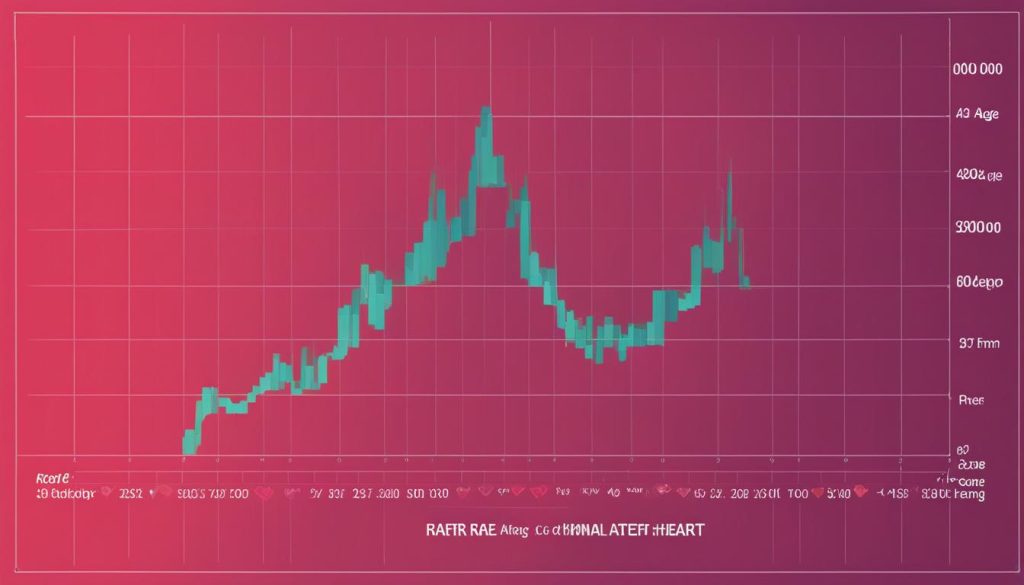Are you curious about what a good resting heart rate is for your age? Understanding your resting heart rate is an essential part of monitoring your overall health and fitness. Your heart rate can provide valuable insights into your cardiovascular well-being. In this article, we will explore the average heart rate by age and delve into the factors that can influence your heart rate.
Resting heart rate refers to the number of times your heart beats per minute while you are in a relaxed state. For individuals aged 15 and up, the normal resting heart rate typically ranges between 60 to 100 beats per minute (bpm).
While this is the general range, it’s important to note that various factors can slightly alter your resting heart rate. Regular exercise, medical conditions, stress, and medication use can all have an impact on your heart rate. Monitoring your resting heart rate can help you gauge your cardiovascular fitness and identify any potential health concerns.
In the following sections, we will discuss why your resting heart rate matters, what the normal resting heart rate is by age, how to measure your heart rate, factors that can affect your heart rate, and when to seek medical attention. We will also explore target heart rate and maximum heart rate during physical activity.
Understanding these aspects will empower you to make informed decisions about your health and take proactive steps towards maintaining a healthy heart rate. So, let’s dive in and discover the fascinating world of resting heart rates!
Why Does Your Resting Heart Rate Matter?
A person’s resting heart rate can provide valuable information about their health. Understanding the guidelines for resting heart rate based on age can help determine if your heart rate falls within the normal range. Both high and low resting heart rates can be indicative of potential medical conditions or health issues, warranting further evaluation.
High Resting Heart Rate
A high resting heart rate, above the established guidelines, may indicate abnormalities in hormone levels, an overactive thyroid, anemia, or heart rhythm irregularities. It is essential to monitor and consult a healthcare professional if you consistently experience above-average heart rates at rest.
Low Resting Heart Rate
A low resting heart rate, below the established guidelines, can also be a cause for concern. It may lead to symptoms such as dizziness, fatigue, and fainting. Medical evaluation is necessary to identify the underlying cause and determine appropriate treatment options.
By paying attention to your resting heart rate, you can identify potential health issues and take proactive measures to maintain a healthy heart rate. Regular monitoring and medical advice can help you stay on track for optimal cardiovascular health.

| Age | Resting Heart Rate Range (beats per minute) |
|---|---|
| Infants (0-11 months) | 70-160 |
| Toddlers (1-2 years) | 80-130 |
| Preschoolers (3-4 years) | 80-120 |
| School-age (5-12 years) | 70-100 |
| Adolescents (13-18 years) | 60-100 |
| Adults (18+ years) | 60-100 |
What is the Normal Resting Heart Rate by Age?
The normal resting heart rate can vary depending on age. According to the National Institutes of Health, the following ranges are considered normal for resting heart rate:
| Age | Resting Heart Rate Range |
|---|---|
| 0-1 month | 70-190 bpm |
| 1-11 months | 80-160 bpm |
| 1-2 years | 80-130 bpm |
| 3-4 years | 80-120 bpm |
| 5-6 years | 75-115 bpm |
| 7-9 years | 70-110 bpm |
| 10 years and older | 60-100 bpm |
Keep in mind that these are general guidelines, and individual variations can occur. It is always essential to consult with a healthcare professional for a more accurate assessment of your specific heart rate.

Understanding your resting heart rate is important for monitoring your cardiovascular health and detecting any potential irregularities. By knowing the normal ranges for your age group, you can better assess your heart’s condition and take appropriate action if necessary.
How to Measure Resting Heart Rate?
Measuring your resting heart rate is a simple process that can be done manually or with the help of technology. By checking your pulse, you can obtain an accurate measurement of your heart rate. Here are two methods you can use:
Method 1: Manual Measurement
To manually measure your resting heart rate, follow these steps:
- Find a quiet and comfortable place to sit down.
- Place your index and middle fingers gently against the underside of your wrist or on the carotid arteries located on each side of your neck.
- Pro tip: Apply light pressure with your fingers to avoid disrupting the pulse.
- Count the beats you feel for 15 seconds.
- Multiply the total by four to determine your heart rate in beats per minute (bpm).
Method 2: Using Smartwatches and Fitness-Tracking Wearables
If you prefer a more convenient way to measure your heart rate, you can rely on smartwatches and fitness-tracking wearables that come equipped with heart rate monitoring features. These devices use optical sensors to detect the blood flow through your veins and can provide real-time heart rate data.
With the advancement of technology, tracking your heart rate has become much simpler and more accessible than ever. Whether you choose to measure your heart rate manually or rely on wearable devices, understanding your resting heart rate can help you make informed decisions about your overall health and well-being.
Factors Affecting Resting Heart Rate
The resting heart rate can be influenced by several factors, which may contribute to an elevated heart rate. Understanding these factors is crucial in determining the possible causes of a high resting heart rate.
Regular Exercise: Engaging in regular physical activity can lead to increased cardiovascular fitness and a lower resting heart rate. On the other hand, a lack of exercise or a sedentary lifestyle can cause the heart to work harder, resulting in a higher resting heart rate.
Fever, Pain, and Infection: Illnesses such as fever, pain, and infection can cause temporary increases in heart rate as the body’s response to stress and inflammation.
Dehydration: When the body is dehydrated, the blood volume decreases, and the heart has to work harder to pump blood, leading to a higher resting heart rate.
Poor Sleep: Inadequate sleep or poor sleep quality can disrupt the body’s natural processes, including heart rate regulation. This can result in an elevated resting heart rate.
Caffeine or Alcohol Intake/Withdrawal: Consumption of caffeinated beverages or alcohol can temporarily increase heart rate. Additionally, sudden withdrawal from these substances can lead to rebound effects, causing a higher resting heart rate.
Stress and Anxiety: Mental and emotional stress, as well as anxiety, can trigger an increase in heart rate. Prolonged periods of stress can contribute to a higher resting heart rate.
Smoking: Smoking tobacco products can cause damage to the cardiovascular system, resulting in a higher resting heart rate.
Use of Over-the-counter Decongestants: Some over-the-counter decongestants contain ingredients, such as pseudoephedrine, that can raise heart rate. These medications should be used cautiously, as they can contribute to an elevated resting heart rate.
Poor Physical Condition: Individuals who are physically unfit may have a higher resting heart rate due to a less efficient cardiovascular system. Regular exercise and improving overall fitness can help reduce resting heart rate.
By addressing these factors and making necessary lifestyle changes, it is possible to manage and lower the resting heart rate. However, if an individual consistently experiences a significantly higher resting heart rate without identifiable factors or other concerning symptoms, it is recommended to consult a healthcare professional for further evaluation and guidance.
Target Heart Rate and Maximum Heart Rate
Understanding target heart rate and maximum heart rate is essential for determining appropriate heart rate zones during exercise. Your target heart rate during moderate-intensity activity, such as walking, should be about 50% to 70% of your maximum heart rate. For more intense activities, aim for a target heart rate of about 70% to 85% of your maximum heart rate.
As a general guide, the American Heart Association provides average maximum heart rates and target heart rate zones by age.
Target Heart Rate Zones by Age
| Age | Target Heart Rate Zone (50%-85%) | Maximum Heart Rate |
|---|---|---|
| 20-29 | 100-170 bpm | 190 bpm |
| 30-39 | 95-162 bpm | 185 bpm |
| 40-49 | 90-153 bpm | 180 bpm |
| 50-59 | 85-145 bpm | 175 bpm |
| 60+ | 80-136 bpm | 170 bpm |
Remember, these are average values, and individual variations may occur. It’s always recommended to consult with a healthcare professional or certified fitness trainer to determine your precise target heart rate zones based on your fitness level and any underlying health conditions.

When to Seek Medical Attention
If you notice a higher resting heart rate without any significant changes in your health, it may indicate the need for increased physical activity to lower your heart rate. However, if your resting heart rate remains persistently elevated above 100 beats per minute for a few days, it is advisable to consult a healthcare professional. Additionally, if you experience symptoms such as chest hurt when you take deep breath, difficulty breathing, dizziness, or fainting accompanied by rapid heartbeats, it is important to seek immediate medical evaluation from a doctor.

It’s essential to pay attention to your heart rate and to be proactive in seeking medical attention when necessary. Monitoring your heart health is crucial in maintaining overall well-being and preventing potential complications.
Conclusion
Maintaining a healthy resting heart rate is vital for overall cardiovascular health. By engaging in regular physical activity, making lifestyle modifications, and effectively managing stress, individuals can lower their resting heart rate and promote heart health.
Understanding the normal resting heart rate range based on age is essential. It allows individuals to track their heart rate and recognize potential abnormalities. By knowing the appropriate resting heart rate for their age, individuals can establish a baseline and identify any deviations that may require medical attention.
Remember, a high resting heart rate may indicate underlying medical conditions or health issues, while a low resting heart rate can be a cause for concern and may require further evaluation. It is crucial to be aware of the signs and symptoms that warrant medical attention, such as chest pain, difficulty breathing, dizziness, or fainting accompanied by rapid heartbeats.
By maintaining a healthy resting heart rate, individuals can contribute to their overall well-being and reduce the risk of cardiovascular diseases. With the right lifestyle choices and proper medical evaluation, individuals can strive for a healthy heart rate and enjoy a healthier, more active lifestyle.




